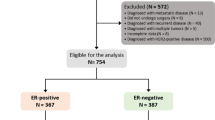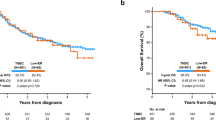Abstract
Background
We investigated the implications of HER2 amplification in Asian women with small, node-negative breast cancer in low- and middle-income countries (LMCs).
Methods
We reviewed the charts patients treated between 1989 and 2009 with breast conservation therapy for node-negative breast cancers measuring ≤2 cm. Disease-free survival (DFS), ipsilateral breast tumor recurrence (IBTR), distant disease-free survival (DDFS), and overall survival (OS) rates were estimated using the Kaplan–Meier method and were compared by the log-rank test. Potential covariates—age, tumor grade, hormone receptor status—were analyzed by multivariate analysis.
Results
A total of 519 patients were studied including 204 (39%) and 315 (61%) patients diagnosed with pT1ab and pT1c tumors, respectively. Median follow-up was 57 months. HER2 amplification was found in 17.1% of all patients and in 16.7% patients with pT1ab tumors. Among patients with T1ab tumors, 73.0 and 9.3% underwent adjuvant hormonal and chemotherapy, respectively; 3 of 34 T1ab patients with HER2-amplified tumors received trastuzumab. HER2 amplification was associated with poorer 5-year DFS (83.7% vs. 95.5%, P < 0.0001), DDFS (87.5% vs. 97.9%, P < 0.0001), and IBTR (8.6% vs. 2.1%, P < 0.0001) rates in patients with pT1 tumors. Multivariate analysis showed that HER2 amplification remained a significant negative prognostic factor for DFS [hazard ratio (HR) 4.1, 95% confidence interval (CI) 2.1–7.8, P < 0.0001], DDFS (HR 6.3, 95% CI 2.4–17.0, P < 0.0001), and IBTR (HR 4.5, 95% CI 2.0–10.0, P < 0.0001) rates. In the pT1ab subgroup, univariate analysis showed that HER2 amplification prognosticated for DFS (85.1% vs. 95.7%, P = 0.022) and IBTR (14.9% vs. 3.5%, P = 0.004) rates but not for the OS (100% vs. 99.2%, P = 0.487) rate. Similar results were obtained after excluding patients given trastuzumab.
Conclusions
The decision to use trastuzumab in HER2-amplified pT1ab tumors must balance their poor outcome against intrinsic financial limitations in LMCs. Patient selection criteria needs fine-tuning, and resource-sensitive regimens must be explored.


Similar content being viewed by others
References
Piccart-Gebhart MJ, Procter M, Leyland-Jones B et al (2005) Trastuzumab after adjuvant chemotherapy in HER2-positive breast cancer. N Engl J Med 353:1659–1672
Romond EH, Perez EA, Bryant J et al (2005) Trastuzumab plus adjuvant chemotherapy for operable HER2-positive breast cancer. N Engl J Med 353:1673–1684
Smith I, Procter M, Gelber RD et al (2007) 2-Year follow-up of trastuzumab after adjuvant chemotherapy in HER2-positive breast cancer: a randomised controlled trial. Lancet 369:29–36
Joensuu H, Bono P, Kataja V et al (2009) Fluorouracil, epirubicin, and cyclophosphamide with either docetaxel or vinorelbine, with or without trastuzumab, as adjuvant treatments of breast cancer: final results of the FinHer Trial. J Clin Oncol 27:5685–5692
Quiet CA, Ferguson DJ, Weichselbaum RR et al (1995) Natural history of node-negative breast cancer: a study of 826 patients with long-term follow-up. J Clin Oncol 13:1144–1151
Curigliano G, Viale G, Bagnardi V et al (2009) Clinical relevance of HER2 overexpression/amplification in patients with small tumor size and node-negative breast cancer. J Clin Oncol 27:5693–5699
Gonzalez-Angulo AM, Litton JK, Broglio KR et al (2009) High risk of recurrence for patients with breast cancer who have human epidermal growth factor receptor 2-positive, node-negative tumors 1 cm or smaller. J Clin Oncol 27:5700–5706
Leong SP, Shen ZZ, Liu TJ et al (2010) Is breast cancer the same disease in Asian and Western countries? World J Surg 34:2308–2324. doi:10.1007/s00268-010-0683-1
Toi M, Ohashi Y, Seow A et al (2010) The Breast Cancer Working Group presentation was divided into three sections: the epidemiology, pathology and treatment of breast cancer. Jpn J Clin Oncol 40(Suppl 1):i13–i18
Anonymous (2009) TNM Classification of Malignant Tumours. Wiley-Blackwell, Hoboken
Selvarajan S, Bay BH, Choo A et al (2002) Effect of fixation period on HER2/neu gene amplification detected by fluorescence in situ hybridization in invasive breast carcinoma. J Histochem Cytochem 50:1693–1696
Panet-Raymond V, Truong PT, McDonald RE et al (2011) True recurrence versus new primary: an analysis of ipsilateral breast tumor recurrences after breast-conserving therapy. Int J Radiat Oncol Biol Phys 81:409–417
Huang E, Buchholz TA, Meric F et al (2002) Classifying local disease recurrences after breast conservation therapy based on location and histology: new primary tumors have more favorable outcomes than true local disease recurrences. Cancer 95:2059–2067
Bowen RL, Stebbing J, Jones LJ (2006) A review of the ethnic differences in breast cancer. Pharmacogenomics 7:935–942
Morris GJ, Naidu S, Topham AK et al (2007) Differences in breast carcinoma characteristics in newly diagnosed African-American and Caucasian patients: a single-institution compilation compared with the National Cancer Institute’s Surveillance, Epidemiology, and End Results database. Cancer 110:876–884
Telli ML, Chang ET, Kurian AW et al (2011) Asian ethnicity and breast cancer subtypes: a study from the California Cancer Registry. Breast Cancer Res Treat 127:471–478
Parise CA, Bauer KR, Brown MM et al (2009) Breast cancer subtypes as defined by the estrogen receptor (ER), progesterone receptor (PR), and the human epidermal growth factor receptor 2 (HER2) among women with invasive breast cancer in California, 1999–2004. Breast J 15:593–602
Chia S, Norris B, Speers C et al (2008) Human epidermal growth factor receptor 2 overexpression as a prognostic factor in a large tissue microarray series of node-negative breast cancers. J Clin Oncol 26:5697–5704
Park YH, Kim ST, Cho EY et al (2010) A risk stratification by hormonal receptors (ER, PgR) and HER-2 status in small (< or =1 cm) invasive breast cancer: who might be possible candidates for adjuvant treatment? Breast Cancer Res Treat 119:653–661
Althuis MD, Dozier JM, Anderson WF et al (2005) Global trends in breast cancer incidence and mortality 1973–1997. Int J Epidemiol 34:405–412
Rodrigues MJ, Wassermann J, Albiges L et al (2010) Trastuzumab treatment in t1ab, node-negative, human epidermal growth factor receptor 2-overexpressing breast carcinomas. J Clin Oncol 28:e541–e542
Leitner SP, Swern AS, Weinberger D et al (1995) Predictors of recurrence for patients with small (one centimeter or less) localized breast cancer (T1a, b N0 M0). Cancer 76:2266–2274
Mann GB, Port ER, Rizza C et al (1999) Six-year follow-up of patients with microinvasive, T1a, and T1b breast carcinoma. Ann Surg Oncol 6:591–598
Bria E, Nistico C, Cuppone F et al (2006) Benefit of taxanes as adjuvant chemotherapy for early breast cancer: pooled analysis of 15,500 patients. Cancer 106:2337–2344
Conflicts of interest
The authors have no conflicts of interest.
Author information
Authors and Affiliations
Corresponding author
Rights and permissions
About this article
Cite this article
Wong, F.Y., Yip, C.S.P. & Chua, E.T. Implications of HER2 Amplification in Small, Node-Negative Breast Cancers: Do Asians Differ?. World J Surg 36, 287–294 (2012). https://doi.org/10.1007/s00268-011-1353-7
Published:
Issue Date:
DOI: https://doi.org/10.1007/s00268-011-1353-7




